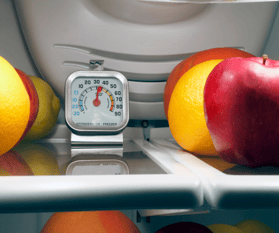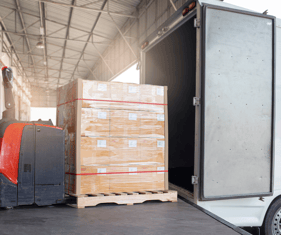Temperature-Controlled and Food-Grade Shipping: Best Practices and Tips for Success
Business Advice | Logistics | Cargo Claims | Transportation | Best Practices | Freight Management | Shippers
Most US consumers rarely think twice about where their food is sourced, how it arrives on retail shelves, or the risks that storage and transportation have on perishable goods. Globally, an astonishing one-fifth of food intended for human consumption is spoiled during transportation and distribution.

In today's global marketplace, the transportation of perishable goods has become increasingly complex. Shippers face the challenge of maintaining the quality, safety, and integrity of temperature-sensitive products throughout their journey from the point of origin to the final destination. Whether it's fresh produce, pharmaceuticals, or other perishable items, effective temperature-controlled and food-grade shipping practices are crucial to ensure that goods reach consumers in optimal condition.
This blog post delves into the world of cold chain shipping, exploring best practices and tips for success. By understanding the significance of temperature control, selecting the right shipping methods, implementing proper packaging and insulation, preparing for loading and unloading, collaborating with reliable carriers and partners, and complying with regulatory standards, you can optimize your operations and safeguard the quality of your perishable cargo.
Understanding the Importance of Temperature Control
Maintaining the appropriate temperature during transportation is vital for preserving the quality, taste, and safety of perishable goods. Temperature fluctuations can accelerate spoilage, compromise the integrity of sensitive products, and increase the risk of bacterial growth or chemical reactions. Recognizing the significance of temperature control in preserving goods' value and shelf life is crucial.
Selecting the Right Shipping Method
Choosing the appropriate shipping method is fundamental to ensuring the integrity of temperature-sensitive loads. Here are a few options to consider:
 Refrigerated Trucks: Refrigerated (or "reefer") trucks are commonly used for transporting large volumes of perishable goods. They provide a controlled environment, allowing for the regulation of temperature and humidity levels throughout the journey. In the US, trucking is the most common way to transport perishable goods, handling about 70% of food shipments under 500 miles.
Refrigerated Trucks: Refrigerated (or "reefer") trucks are commonly used for transporting large volumes of perishable goods. They provide a controlled environment, allowing for the regulation of temperature and humidity levels throughout the journey. In the US, trucking is the most common way to transport perishable goods, handling about 70% of food shipments under 500 miles. - Air Freight: Air cargo is an efficient mode of transportation for time-sensitive perishables. It offers faster transit times and reliable temperature control, making it ideal for transporting high-value goods such as pharmaceuticals.
- Ocean Freight: For long-distance shipments, ocean freight with temperature-controlled containers is a cost-effective option. These containers provide insulation and regulated temperature settings to safeguard products during transit.
- Courier Services: Local or regional courier services equipped with temperature-controlled vehicles are suitable for smaller shipments that require rapid delivery, such as fresh food or medical supplies.
Utilizing Proper Packaging and Insulation
Packaging and insulation materials play a critical role in temperature-controlled shipping. Consider the following guidelines:
- Insulated Containers: Use containers that provide effective thermal insulation, such as vacuum-sealed, foam-insulated, or double-walled options. These containers help maintain a consistent temperature throughout the journey.
- Temperature Monitoring Devices: Employ temperature monitoring devices, such as data loggers or sensors, inside the shipping container. These devices provide real-time temperature data, allowing for immediate intervention if any deviations occur.
- Proper Sealing: Keep containers tightly sealed to prevent temperature leaks or contamination. Use quality seals and adhesive tape specifically designed for temperature-controlled shipping.
- Cold Packs or Dry Ice: Depending on the temperature requirements, include cold packs or dry ice in the packaging to maintain the desired temperature range. Follow safety regulations and guidelines for handling and labeling.
Preparing for Loading and Unloading
Efficient loading and unloading processes are crucial to minimizing temperature fluctuations and maintaining product quality. Consider the following tips:
 Pre-Cooling: Pre-cool the storage space, refrigerated truck, or container before loading to reduce the temperature shock to the products.
Pre-Cooling: Pre-cool the storage space, refrigerated truck, or container before loading to reduce the temperature shock to the products.- Proper Stacking: Organize the shipment in a way that allows for adequate airflow within the container. Ensure that temperature-sensitive items are not stacked directly against the walls or near the cooling units.
- Quick Transfer: Minimize the time spent during loading and unloading operations to reduce exposure to ambient temperatures. Assign well-trained personnel to handle the process promptly and efficiently.
Collaborating with Reliable Carriers and Partners
Selecting experienced carriers and partners who specialize in temperature-controlled shipping is crucial. Look for the following qualities:
- Expertise and Accreditation: Choose carriers and partners with extensive experience and proven expertise in temperature-controlled logistics. Verify their compliance with industry standards and certifications, such as Hazard Analysis and Critical Control Points (HACCP).
- Monitoring Capabilities: Collaborate with partners who provide real-time tracking and monitoring services. Armstrong, for instance, partners with Carrier411 and SaferWatch. This ensures transparency and enables proactive intervention if any deviations occur.
- Contingency Planning: Work with carriers that have robust contingency plans in place to handle unforeseen events or disruptions. This includes backup refrigeration systems, alternative routes, and communication protocols.
Compliance with Regulatory Standards
Adhering to regulatory standards and guidelines is crucial when dealing with temperature-controlled and food-grade shipping. Some important considerations include:
 FDA Regulations: Familiarize yourself with the regulations set forth by the Food and Drug Administration (FDA) in your respective country. Ensure compliance with guidelines on storage, transportation, and handling of food and pharmaceutical products.
FDA Regulations: Familiarize yourself with the regulations set forth by the Food and Drug Administration (FDA) in your respective country. Ensure compliance with guidelines on storage, transportation, and handling of food and pharmaceutical products.- International Standards: If involved in international shipping, be aware of international standards such as the European Union's Good Manufacturing Practice (GMP) guidelines.
- Documentation and Record-Keeping: Maintain accurate and up-to-date records of temperature monitoring data, maintenance logs, and compliance documentation. These records are essential for audits, inspections, and traceability.
Leverage Armstrong for Reliable Temperature-Controlled Shipping Solutions
We're here to serve as a trusted partner for all your cold chain solutions. With our extensive experience, industry accreditations, and commitment to excellence, we offer a comprehensive suite of services designed to meet your needs. We understand the unique challenges of transporting perishable goods; that's why we only leverage carriers with state-of-the-art equipment, technology, and dedicated professionals to ensure optimal temperature control every step of the way.
Don't leave the quality and safety of your temperature-sensitive shipments to chance! Visit our website to discover how our specialized services can benefit your business.
About Stephanie Wilson
With over 20 years of experience, Stephanie handles the intake and administration of cargo claims while also resolving emergencies such as hostage loads. As Armstrong's Claims Manager, Stephanie is also responsible for streamlining the department and fostering transparency in the claims process.



